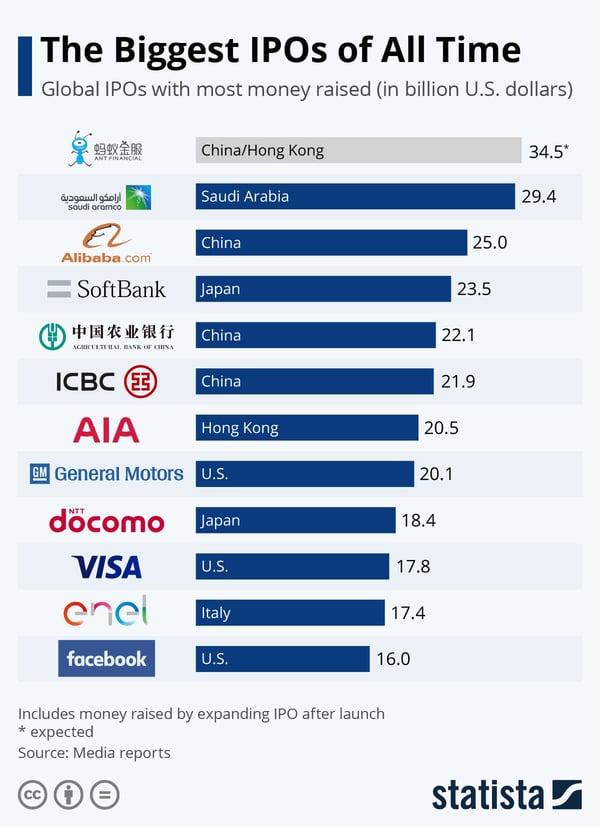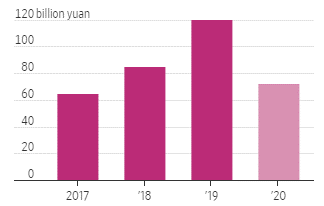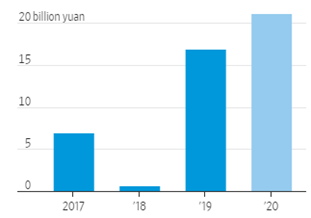If Chinese billionaire Jack Ma already broke the record for the biggest IPO with Alibaba - $25 billion in 2014 – he just did it again with Ant Group, making the largest share sale in history.
The largest IPO the world has ever seen
After its $34.5 billion IPO announcement, the Ant group is now valued at around $313.37 billion, making it the world’s fourth-largest financial company. It is now larger than some of the US’s biggest banks such as Wells Fargo and Goldman Sachs. Ant is also worth more than the Industrial and Commercial Bank of China, the world’s biggest bank by assets. It just beat Aramco for the biggest IPO ever, who used to hold the title with a $29.4 share sale.
The company filed a dual listing on the Hong Kong Stock Exchange and the Shanghai STAR market at $10.32 and $10.26 a share, respectively. This means that Ant group is traded at 31.4 times 2021 earnings and 24.2 times 2022 earnings forecasts. For comparison purposes, you may note that Alibaba is trading at 34.28 times earnings.
Pre-orders went fast, as such an event was long awaited. Many investors placed orders of at least $1 billion in the first hour of the opening. The total number of institutional orders could reach about 1’000. Jack Ma called the fact that such an IPO took place outside of the New York Stock Exchange a “miracle”.

Key background
Founded in 2011, Ant Group is an affiliate company of the Chinese Group Alibaba and dominates the Chinese payment market. In 2014, Alipay was renamed Ant Financial and raised $4.5 billion.
Today, Ant Group is now the world’s highest-valued fintech, with a valuation of $313 billion. The company operates Alipay, largest mobile and payment platform in the world, as well as Yu’e Bao, the world’s largest money-market fund, and various other daughter companies in different industries.
An interesting information for investors is that Ant reported a profit 21.9 billion yuan (US$3.2 billion) on a total revenue of 72.5 billion yuan (US$10.6 billion) for the first half of 2020. That is no less than a 1000% year-on-year profit – 2019 numbers were 1.9 billion yuan (US$278 million) in profit, and a revenue of 52.5 billion yuan (US$7.7 billion). That is some growth is it not?

Total revenue per year (source: Wall Street Journal)

Total revenue per year (source: Wall Street Journal)
In order to understand the DNA of this giant colony, let’s explore their main participants one by one:
The $17 trillion giant: Alipay
Alipay was founded by the e-commerce giant Alibaba as a new method of payment for the platform. The service was well adopted and quickly expanded to other platforms. So much so that in 2009, the mobile version held no less than 75% of market shares, before being pushed back to 55% after the rise of WeChat Pay, who’s also performing really well in China.
Today, the company has no less than 1.3 billion active users who buy any sort of products, from the morning coffee to cars, and even real estate. The app generated no less than $17.7 trillion in the last 12 months.
The master loaners: Huabei and Jiebei
Don’t have any money to spend with Alipay? Did you really think that it meant you could not buy things? Of course not. Huabei and Jiebei are services offering unsecured loans: the former focuses on little spending (phone, computer, couch) and the latter finances larger spending such as travel, education, and cars.
Although Ant uses some of its own cash reserve for lending, most of the money comes from banks, with the platform only acting as the connector. Goldman Sachs predicts that the amount of their loans could reach 2 trillion by 2021.
The cash-making machine: Yu’ebao
Capitalizing on the enormous inflows of cash coming in Alipay, Yu’ebao is a money market funds which lets user earn money from the cash they parked on the platform. They recently partnered with Vanguard Group to offer the service of a robot advisor in addition to their 20 asset managers.
Yu’ebao is acclaimed as a “fund for the masses” because it removed the entry barriers which stopped most small investors from getting returns higher than bank deposits. Indeed, you can invest as little as one yuan. Yu’ebao Money Market Fund now has $173 billion in assets, making it the world’s largest of its kind.
The judge: Zhima Credit
Strong with an enormous amount of data based on their various lending and payments activities, Ant launched a credit scoring service called Zhima Credit. Founded in 2015, it is able to judge the credit worthiness of Ant’s customers with a laser precision. Not only does the algorithm analyze your expenses and the payment of your bills, it also takes into account your school degrees and the credit score of your friends.
Companies can use the service in exchange of a certain fees, and customers with a sufficiently high score can pass on paying deposits for renting good or staying in hotels.
The Insurer: Xianghubao
In 2019, the company decided to enter the insurance market. The idea is rather simple: clients spay a small monthly fee that is pooled to cover treatment for diseases such as cancer, Alzheimer’s or Ebola. The company also proposes insurance premiums from other companies and takes a cut on price.
With a fee as small as US$4 a year, the company attracted 150 million users in two years, who can benefit from a coverage of up to US$42’000.
Will the Giant leave China?
As you might guess, this enormous growth will soon be too much for one country only, even if the country is China. Ant had to delay its expansion to the U.S. because of recent tensions between the two powers. In 2018, Jack Ma had promised to create a million jobs in the U.S., but sadly, he could not deliver.
In the meantime, the group is consolidating his presence in Asia, partnering with different payment startups (Paytm, Gcash) as well as delivery platforms and other marketplaces in order to address an even larger pool of customers.
Potential tensions ahead
Such an expansion can of course not go unnoticed. China’s regulators are all looking closely at Ant’s development and operations, not always with a good eye. The Chinese central bank is also working on a new project to control the stability of payment systems which could be very harmful to Ant: a digital Yuan.
Ant also remains concerned with the tensions between the U.S. and China, as further bans, restrictions and tensions between the two powers could be very harmful to their expansion plans.
In the meantime, Ant focuses on consolidating the Asia market. To quote Citibank: “Ant Financial is building an Empire of Services”. And this could not summarize things better. Tackling payment, insurance, loan and credit scoring at the same time is a dauting task. We can only imagine how far the company will go, especially after all this new amount of cash at their disposal.

Sources:
China Market Update: Ant Group Files For Hong Kong IPO, US-China Trade Teams Talk, in Forbes
Ant Group's Chinese IPO could be among the biggest in history, in CNN Business
All you need to know about Jack Ma’s Ant Group, in the Star
Ant Group IPO: 3 key investment themes ahead of listing, in IG Bank blog
Ant Financial Ramps Up SEA Capital With $1B Fund, in PYMNTS
Inside Ant Group’s Giant Valuation: One Billion Alipay Users and Big Profit Margins, in the Wall Street Journal
In Depth: How New Mutual Aid Platforms Fill a Hole in China’s Health-Care Coverage, in Caixin Global
Yu'ebao: A Brief History of the Chinese Internet Financing Upstart, in Forbes
Ant Group raises $34 billion in world's largest IPO, in CNN Business
Investors line up for Ant Group's record $34.4 billion IPO, in Reuters
Ant Group Will Become Largest IPO Ever, in the Morning Brew





